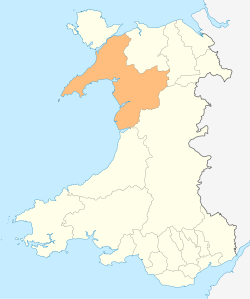| Rhosgadfan | |
|---|---|
 Rhosgadfan Chapel | |
Location within Gwynedd | |
| OS grid reference | SH506572 |
| Community | |
| Principal area | |
| Country | Wales |
| Sovereign state | United Kingdom |
| Post town | CAERNARFON |
| Postcode district | LL54 |
| Dialling code | 01286 |
| Police | North Wales |
| Fire | North Wales |
| Ambulance | Welsh |
| UK Parliament | |
| Senedd Cymru – Welsh Parliament | |
Rhosgadfan is a Welsh village in the county of Gwynedd, formerly part of the historic county of Caernarfonshire, and within the community of Llanwnda. It is notable as the birthplace of Kate Roberts, one of the greatest Welsh-language writers of the 20th century; her childhood home is now a museum (see below).


